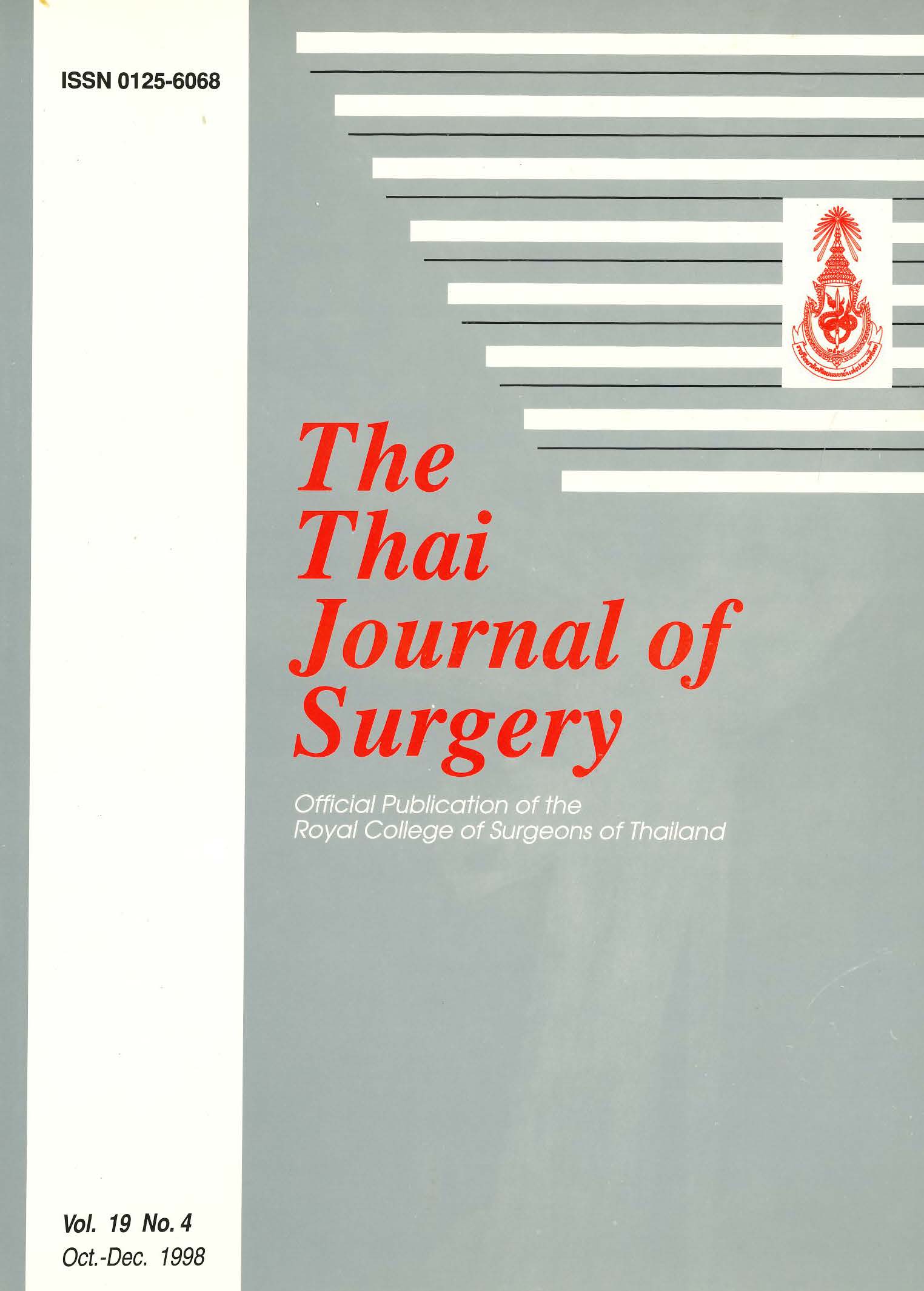Result of Breast Cancer Survival and Prognostic Factors at National Cancer Institute (Thailand) during 1992-1996
Abstract
Breast cancer is a common leading cancer in Thai women. A retrospective, non-randomized, analysis of 873 cases of breast cancer treated at the National Cancer Institute in Bangkok from June 1, 1992 to December 31, 1996 was made. Their medical records were reviewed to the date of last follow-up or the confirmation of death certificate. Data studied included the disease staging, primary tumor size, axillary Iymph node status, estrogen receptor (ER) and progesterone receptor (PR), histologic type and grading, systemic metastasis, marital status, education level, treatment and survival.
The per cent of patients classified by staging 1-4 were 8.1, 51.2, 29. 0 and 11.7 per cent respectively. Their mean age was 48.34 years, ranging 22-85 years. Chemotherapy was given in 72.6 per cent after surgery and in combined treatment with radiation in the cases of stages 2 and 3. Majority of histologic type was ductal carcinoma (80.9 per cent). The overall 5-year survival was 50.4 per cent. By the Anova test. over all survival was statistical significantly related to staging of cancer, size of primary tumor, number of involved axillary lymph nodes, histologic type and grading of tumor. systemic metastasis, marital status, patients' education, and types of treatment.
References
2. IRCA Technical Report No 34; Cancer in Thailand 1992- 1994;11:21-2.
3. Caleffi M, Fentiman IS, Brikheal BG. Factor at presentation influencing the prognosis in breast cancer. Eur J Cancer Clin Oncol 1989: 25(1):51-6.
4. Koiias J, Elston CW, Ellis IO, Robertson JFR, Blamey RW. Early onset breast cancer histopathological and prognostic consideration. Br J Cancer 1997; 75(9):1318-23.
5. Collett K, Hartveit F, Skjaerven R, Maehle BO. Prognostic role of estrogen and progesterone receptors in patients with breast cancer: relation to age and lymph node status. J Clin Pathol 1996;74(1):301-10.
6. Rosen PP, Groshen S. Factor influencing survival and prognosis in early breast carcinoma (T1N0M0-T1N1M1). Assessment of 644 patients with median follow up of 18 years. Surgical clinics of North America 1990; 70(40): 937-61.
7. Haybittle J, Houghton J, Baum M, Social class and weight as prognostic factors in early breast cancer. Br J Cancer 1997; 75(5):729-33.
8. International Uion Against Cancer. Committee on TMN classification: TNM classification of breast cancer, Surgery. The biological basis of modern surgical practice WB. Saunders Com, 1997:573.
9. Fisher B, Redmond C, Fisher ER, et al. Relative worth of estrogen or progesterone receptor and pathologic characteristics of differentiation as indicators of prognosis in node negative breast cancer patients. Finding from National Surgical Adjuvant Breast and Bowel Project Protocol (B 06). J Clin Oncol 1988: 6:1076-87.
10. Silver SR, Daidone MG, Luisi A, et al. Biologic and clinical pathologic factors as indicator of specific relapse type in node negative breast cancer. J Clin Oncol 1995; 13:697- 704.
11. Arriagada R, Rutquist LE, Skivg L, et al. Prognostic factors and natural history in lymph node negative breast cancer patients. Breast Cancer Res Treat 1992:21:101-9.
12. Eddy DM, screening for breast cancer. Ann Intern Med 1989; 111:389-99,
13. Kaluzny AD, Rimer B, Harris B. The National cancer institute and guideline development: Lesson from breast cancer screening controversy. J Natl Cancer Inst 1994; 86:901-3.
14. Ravdin PM. Prognostic factors in breast cancer. ASCO 33rd Annual Meeting 1997:217-25.
Downloads
Published
How to Cite
Issue
Section
License
Articles must be contributed solely to The Thai Journal of Surgery and when published become the property of the Royal College of Surgeons of Thailand. The Royal College of Surgeons of Thailand reserves copyright on all published materials and such materials may not be reproduced in any form without the written permission.



